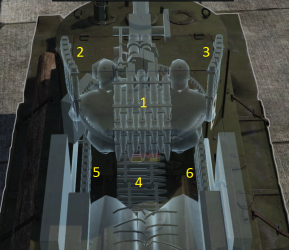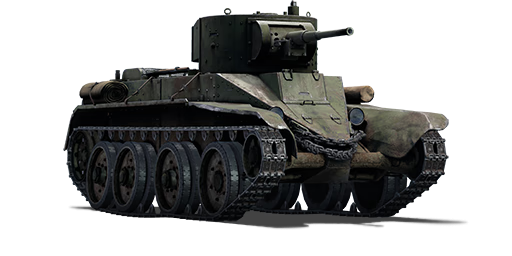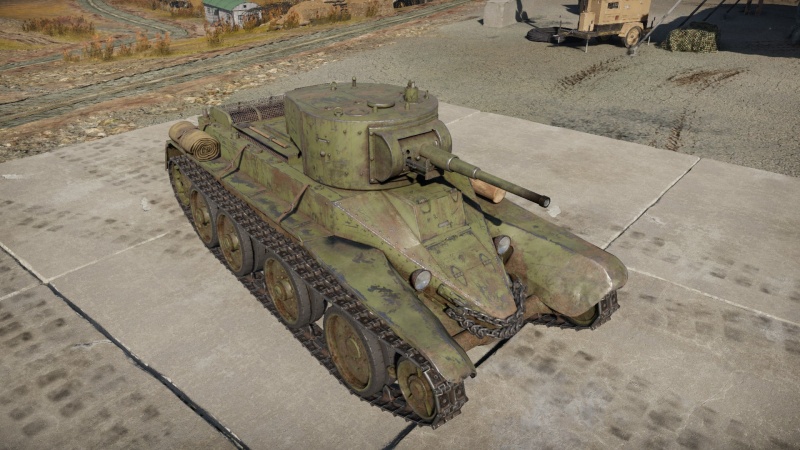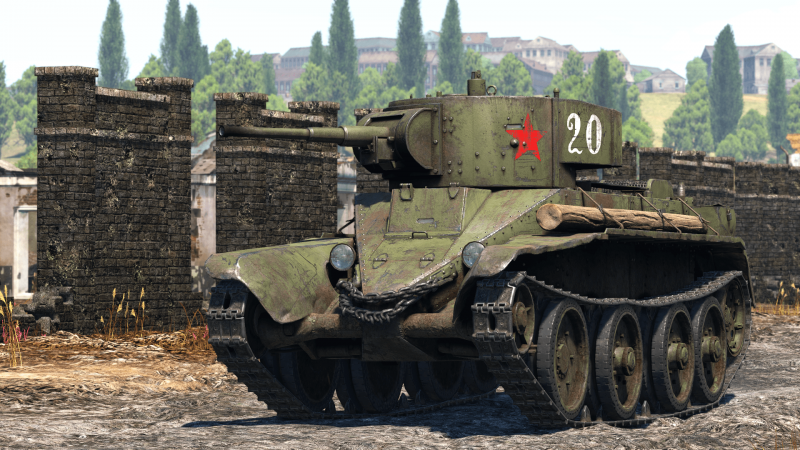BT-5
| This page is about the Soviet light tank BT-5. For the gift version, see RBT-5. |
Contents
Description
The BT-5 (Быстроходный танк-5) is the fifth variant of the BT light tank family. It is designed as a convertible tank, a feature invented by J. Walter Christie to reduce wear on the 1930s' unreliable tank tracks. The main advantage of this design is that the tank crew can quickly remove the tracks and connect a chain drive to the rearmost road wheel on each side, allowing the tank to travel at extremely high speeds on roads. The BT-5 variant, which featured a larger cylindrical turret housing a 45 mm 20-K tank gun and a coaxial 7.62 DT light machine gun, proved useful in the early stages of World War II. However, Soviet designers quickly discovered that the convertible option was of little practical use in a country with few paved roads; it took up space and added unnecessary complexity and weight. Later variants did not include the feature.
Introduced in Update 1.45 "Steel Generals", the BT-5 is versatile in terms of playstyle due to its great mobility and reasonable firepower. Given its impressive top speed, this tank is best used to capture objectives early in the game. It is recommended to travel on the road to fully utilize its speed and arrive at the objectives before the enemies. Another good strategy is to move to the border of the battlefield and engage enemies from the side. Its speed allows it to reach unexpected areas early in a battle, surprising the enemies. However, players must be careful not to expose themselves during battles as the tank is lightly armoured, thus any penetrating shots will almost certainly result in destruction.
General info
Survivability and armour
The BT-5 has a poor survivability: its armour is almost non-existent on all sides, making it vulnerable to autocannons (Pz.II, Flakpanzer I, etc.) and heavy machine guns like .50 cal HMGs found on American vehicles. Moreover, the crew is tightly packed, making it easy to knock out the BT-5 with a single shot by taking out all three crewmen at once.
Armour type:
- Rolled homogeneous armour
| Armour | Front | Sides | Rear | Roof |
|---|---|---|---|---|
| Hull | 13 mm (62°) Front glacis 20 mm (18°) Driver port 30 mm (62°) Lower glacis 40 mm (13°) Plate joint |
15 mm (1°) | 13 mm (0-59°) | 10 mm |
| Turret | 20 mm (11-43°) Gun mantlet 15 mm Turret front |
15 mm | 15 mm | 10 mm |
Notes
- Tracks and suspension wheel are both 15 mm thick.
Mobility
| Game Mode | Max Speed (km/h) | Weight (tons) | Engine power (horsepower) | Power-to-weight ratio (hp/ton) | |||
|---|---|---|---|---|---|---|---|
| Forward | Reverse | Stock | Upgraded | Stock | Upgraded | ||
| Arcade | 57 | 12 | 11.6 | 396 | 763 | 34.14 | 65.78 |
| Realistic | 51 | 10 | 323 | 400 | 27.84 | 34.48 | |
Modifications and economy
Armaments
Main armament
The BT-5 has a decent cannon for a light tank. Stock round has a maximum penetration of 70 mm. Combined with the 29 g TNT, it is almost certain that the BT-5 will frontally knock out every tank it will see. Even at more than 500 m away from the target, it still has 40-50 mm of penetration which is still enough to go through a lot of tanks' frontal armour. The 3-4 second reload allows the player to quickly fire more shells if the first shot didn't kill. The tank has 8 degrees of gun depression which is enough for most terrain.
| 45 mm 20-K | Turret rotation speed (°/s) | Reloading rate (seconds) | |||||||||||
|---|---|---|---|---|---|---|---|---|---|---|---|---|---|
| Mode | Capacity | Vertical | Horizontal | Stabilizer | Stock | Upgraded | Full | Expert | Aced | Stock | Full | Expert | Aced |
| Arcade | 86 | -8°/+25° | ±180° | N/A | 15.23 | 21.08 | 25.60 | 28.31 | 30.12 | 3.77 | 3.34 | 3.07 | 2.90 |
| Realistic | 9.52 | 11.20 | 13.60 | 15.04 | 16.00 | ||||||||
Ammunition
| Penetration statistics | |||||||
|---|---|---|---|---|---|---|---|
| Ammunition | Type of warhead |
Penetration @ 0° Angle of Attack (mm) | |||||
| 10 m | 100 m | 500 m | 1,000 m | 1,500 m | 2,000 m | ||
| BR-240 | APHEBC | 70 | 67 | 58 | 47 | 39 | 32 |
| BR-240SP | APBC | 73 | 70 | 60 | 50 | 41 | 34 |
| Shell details | ||||||||||||
|---|---|---|---|---|---|---|---|---|---|---|---|---|
| Ammunition | Type of warhead |
Velocity (m/s) |
Projectile mass (kg) |
Fuse delay (m) |
Fuse sensitivity (mm) |
Explosive mass (TNT equivalent) (g) |
Ricochet | |||||
| 0% | 50% | 100% | ||||||||||
| BR-240 | APHEBC | 760 | 1.43 | 1.2 | 9 | 29.26 | 48° | 63° | 71° | |||
| BR-240SP | APBC | 757 | 1.43 | - | - | - | 47° | 60° | 65° | |||
Ammo racks

| Full ammo |
1st rack empty |
2nd rack empty |
3rd rack empty |
4th rack empty |
5th rack empty |
6th rack empty |
Visual discrepancy |
|---|---|---|---|---|---|---|---|
| 86 | 72 (+14) | 57 (+29) | 43 (+43) | 29 (+57) | 15 (+71) | 1 (+85) | No |
Turret empty: 29 (+57)
Machine guns
| 7.62 mm DT | ||||
|---|---|---|---|---|
| Mount | Capacity (Belt) | Fire rate | Vertical | Horizontal |
| Coaxial | 1,890 (63) | 600 | N/A | N/A |
Usage in battles
The BT-5 is really flexible when it comes to usage, as it has great mobility and firepower, which is pretty much all you need for a good tank. Given its great 53 km/h top speed, it is good to use the BT-5 as a point-capturing tank at the start of the match. It is better to travel on-road to fully utilise its speed to get to the point before the enemies do. Another good tactic is to manoeuvre to the flank of the frontline/point and attack from the side. Its speed makes it possible to go the furthest in the shortest time, surprising the enemies.
Once captured, the player can either quickly set an ambush behind nearby cover waiting for the enemy to recapture it, or just drive around the battlefield and help teammates. Its 70 mm penetration and 29 g TNT APHEBC shell will one-shot pretty much anything around its BR. If not, the 3 second reload allows it to finish them off easily. A sudden, close encounter is a hard test to the player's skills because the BT-5 isn't very good at turning as its tracks are quite long and narrow. Its turret traverse of around 11 deg/sec is certainly not the best. Thus those two factors can sometimes cause the death of the BT-5 so the player must respond fast and accurate.
Enemies worth noting:
- Pz.IIs - Although not as fast as the BT-5, the Pz.IIs still have an average speed of around 40 km/h. Also, they are equipped with a deadly 20 mm autocannon that will punch holes on the BT-5 with ease, and their rate of fire can quickly kill multiple crew. The BT-5 has thin armour protecting only 3 crew, making it extremely vulnerable to those autocannons.
- Sd.Kfz.234 series - These wheeled vehicles all have scary on-road speeds of more than 60 km/h, so in any map, with roads connecting to the points they can always get there first and set up an ambush. However, these vehicles are wheeled meaning they cannot turn in place, they are rather sluggish when trying to turn, and they have either slow turret traverse or no turret at all, so the player can use this to their advantage. Wiggle/circle around them to avoid their guns and force them to turn, then aim carefully and immobilise them. Note that the DT machine gun on the BT-5 only has 10 mm penetration at most, making it almost impossible to go through their armour and kill any crew, so don't think of destroying these wheeled vehicles with the MG.
- M8 Greyhound, M3 Stuarts - These vehicles are equally fast, and the M8 can outrun the BT-5 if it's travelling on road, allowing them to get to the point before the BT-5 does. Therefore, if America is on the other side the player might want to change their tactics and not rush the point since low tier battles are always filled with fast tanks. The M8 has a roof-mounted .50 cal MG which easily tears the BT-5's armour apart and kills the crew inside. Also, most of them have a vertical stabiliser that works at low speed, so avoid firing on the move with them.
- B1 bis - A heavily armoured tank for its BR, but do not panic when you see it. Don't fire at a distance unless you are directly aiming at its side armour. The best option is to try and get as close to it as possible (point-blank range is ideal) and shoot straight at its side. However sometimes due to a variety of reasons the player might be unable to flank it and has to face it frontally. If that is the case, shoot the rather vertical driver's compartment and there's a great chance of penetration, killing the driver and the commander (which is also the gunner for the turret). Or, shoot between the two guns on the turret to kill the commander/gunner. Or, shoot at the near-vertical part of the curved gun mantlet of the big hull-mounted gun.
Pros and cons
Pros:
- Deadly firepower at its BR: high penetration of up to 70 mm, and shells have explosive filler which can frontally knock out most tanks like Pz.IIs, Chi-Has or M3 Stuarts with a single shot
- Fast tank, great acceleration and overall mobility
- 3-4 second reload time is quick enough to destroy opponents it could not take out with a single shot, like Pz.IV C and LVT(A) series
- Adequate gun depression of 8 degrees allows it to adapt to hilly terrain well
- Small and low profile allows it to easily hide behind cover or bushes
Cons:
- Poor survivability
- Turret and hull traverse is rather slow, meaning it may not be able to keep track of fast targets- this is also a disadvantage in a close-quarters duel, as other light tanks like M3 Stuart can turn way faster
History
Development
The BT, or Bystrokhodny tank ("Fast tank"), was a strange combination of national engineering. Its origin lies with the American automotive designer Walter Christie, who developed a suspension system that can be converted between tracked and wheeled travel. His first attempt was the M1919 tank submitted to the US army in February 1921, but was withdrawn for improvements in Spring 1921. It was rebuilt as the M1921 and tested until May 1923. While his design had garnered interest, the deficiency of the cramped crew compartment and unreliable had the design rejected in July 1924. Christie improved the suspension again and patented the design in April 1928. The new suspension used large road wheels with a smaller idler and drive sprocket, with a chain to drive the vehicle track-less when needed. The suspension wheels were supported by large springs in the hull to provide a relatively smooth ride compared to the usual suspension design of the day. This design, today is known as the Christie Suspension, was put onto the M1928 tank and presented on October 1928, with a public demonstration by driving the tank from Maryland to Pennsylvania on an average 28 mph speed. The attention grabbed overseas interest, one was the Polish Army, but another country interested in the design was the Soviet Union. The Soviet Union, using its ties with Amtorg Corporation in New York, offered to buy the M1928 design and its license production rights. The deal was done on 30 April 1930 with two M1928 tanks for $60,000 and the production rights for $100,000.[1]
The tanks that arrived at the Soviet Union were designated the M1940 convertible tank. Polish interest in the vehicle vanished upon learning of the transaction with the Soviet Union. However, while the Soviet Union was aware of Polish interest in the vehicle, they did not hear of the cancellation and made estimations that Poland could have up to 100 Christie tanks with 300 Vickers tanks by 1931, prompting a hasty production schedule of their own tank designs. Though with flaws, the M1940 was accepted for production on 23 May 1931 as the BT-2. Manufacturing difficulties led to a delay in the production tables of the BT-2. Another issue was the choice of armament, with the Red Army jumping from the 37 mm PS-2 gun derived from the French Hotchkiss gun, the 37 mm Pak36 developed by Germany, then the 45 mm. The changes in armament, each larger than the other, created fitting issues with the BT-2 turret design. Despite 620 units produced by 1944, the BT-2 was deemed near useless except for practice.[1] An improvement was needed for the service of the Red Army.
The BT-2 design was improved at the KB-T2K tank bureau, with BT-3 being a measurement conversion from imperial to metric, and the BT-4 changing the rivet construction with welds. In 1932, the plan was to upgrade the BT-2 and equip it with 45 mm. The next iteration, the BT-5, was completed on 21 October 1932 without a turret, though with the complete model made on 01 January 1933. The most notable change between the BT-2 design and the BT-5 was the enlarged turret for the 45 mm gun with a coaxial machine gun. Most BT-5 were equipped with the M-5 Liberty gasoline engine, but some were equipped with a BD-2 diesel engine designated the BT-5diz.[2]
A total of 1,946 BT-5 were produced during its production life between 1933 and 1934.[2][3] Aside from the tank model, many different variants were produced on the BT-5 design. Such as the BT-5PKh designed for deep-wading[4], the RBT-5 that equipped two 250 kg 305 mm Tverskiy "Tank Torpedoes" on the turret, a BT-5 with two Katyusha launch rails,[5] the KhBT-5 with a KS-34 flamethrower,[6] and the SBT-5 bridge-layer engineer vehicle. [7] All were built with varying levels of success and practicality, only the SBT-5 were made in noticeable numbers, of which was five units.[7]
Combat usage
The BT-5 was first used to equip the 5th Kalinovskiy Mechanized Corps. 325 BT-5 were equipped with the 71-TK Shakal radio transceiver, designated the BT-5RT.[2] Tanks without radio had to communicate via signal flags, hand signals, or by flare.[3]
The BT tank's first combat usage was during the Spanish Civil War in 1937 in foreign hands, with 50 BT-5 sold to the Spanish Republic, delivered on 10 August 1937. The Spanish troops using them regarded the BTs as the best tanks in Spain. Soviet advisors from the 5th Kalinovskiy Mech. Corps were also supplemented among the Spanish troops during the war. However, the lack of tactics in the Spanish Republicans led to heavy losses among the BT units. Some BTs were even captured by the Spanish Nationalists and used against their owners. [8]
The Soviet's first usage with the BT tanks was in the border conflicts with Japan at Khalkin Gol. At this point, the BT-7 was starting to succeed the BT-5 in Red Army service, but the BT-5 still served in the 11th Tank Brigade in three battalions. Though the BT were successful in stopping Japanese advances and driving them back, the BT tanks suffered casualties under the 37 mm anti-tank guns and 70 mm field guns in Japanese service. While experience with the BTs was still satisfactory, the fighting revealed flaws in the design. The BT armour was becoming too thin to resist standard anti-tank weaponry, radio sets were too easily damaged, rubber on the wheels would melt off in prolonged march in hot weather,[8] and the tank's petrol were catching fire due to combat damages, leading to a change in Soviet power design from petrol engines to diesel.[9]
The BT-5 also saw use during the Soviet's invasion of Poland in 1939, with only 147 BT-2 and BT-5 in four tank regiments but these did not see much combat. A number were also used in the Winter War against Finland in 1940. In April 1941, months before the German's Operation Barbarossa, the Soviets still had 1,658 BT-5 of all variants in inventory, but wear and tear had begun taking their toll on their reliability. Mechanical problems became rampant and when the Germans invaded Russia on 22 June 1941, many BT tanks were lost from breakdowns. Those that were able to encounter the German Panzer divisions were clearly outmatched by the Panzer III and Panzer IV. They were only a match against light tanks like the Panzer 38(t), but the German's more experienced tank formations were able to win even when outnumbered.[8]
The drastically reduced BT tank numbers meant they were almost a rarity past 1941. In the Summer 1942 fronts, there were only 65 BT tanks fighting the Germans. By June 1945, only 299 BT tanks were still available in all parts of the European theatre. The BT's last major campaign was in Manchuria during the Soviet's offensive against Japan. Though majorly BT-7s, 190 BT-5s were present by September 1945. In 1946, all BT tanks were retired from Soviet service.[8]
Legacy
Perhaps the most important impact of the BT light tanks series was that it was the predecessor of the T-34 medium tank[3], which would go on as the most-produced tank of World War II. During work on improving the BT design that would become the BT-7, a separate design project at Kharkov headed by a designer named Mikhail Koshkin in October 1937 focused on a BT-20,[3] which had a wider hull and a BD-2 diesel engine. Inside the design bureau, however, the design was renamed the A-20, which was further improved into the A-32 which had improved armour and a bigger 76.2 mm gun. Finally, in December 1939, Stalin approved the A-32 design, which was accepted under the name T-34[9]
| Archive of the in-game description | |
|---|---|
|
The BT-5 light tank was built as a result of a project to upgrade the BT-2. The first vehicles were released in March, 1933. The new tank's main distinction was that it had a new turret with enhanced weaponry installed on it. A pair of 45 mm 20K cannon and a 7.62 mm DT machine gun were installed on the turret. Other less significant changes were also made that enhanced the tank's build quality. 230 BT-5 tanks with enhanced turrets were produced. | |
Media
- Skins
- Videos
See also
Links to the articles on the War Thunder Wiki that you think will be useful for the reader, for example:
- reference to the series of the vehicles;
- links to approximate analogues of other nations and research trees.
External links
- [Vehicle Profile] A very Soviet Reserve: BT-5 Light Tank
- [Wikipedia] BT tank
- [Tanks Encyclopedia] BT-5
References
- Citations
- ↑ 1.0 1.1 Zaloga 2016, American Origin
- ↑ 2.0 2.1 2.2 Zaloga 2016, The BT-5 Tank
- ↑ 3.0 3.1 3.2 3.3 Zaloga 2016, The BT-7 Tank
- ↑ Zaloga 2016, The PT-1 Amphibious Tank
- ↑ Zaloga 2016, BT Artillery Tanks
- ↑ Zaloga 2016, Flamethrower Tanks
- ↑ 7.0 7.1 Zaloga 2016, Engineer Support Tanks
- ↑ 8.0 8.1 8.2 8.3 Zaloga 2016, Combat Use
- ↑ 9.0 9.1 Zaloga 1994, Design and Development
- Bibliography
- Zaloga, Steven. BT Fast Tank: The Red Army's Cavalry Tank 1931-45 Great Britain: Osprey Publishing Ltd., 2016
- Zaloga, Steven. T-34/76 Medium Tank 1941-45 Great Britain: Osprey Publishing Ltd., 1994
| Kharkov Design Bureau for Mechanical Engineering named after A. A. Morozov | |
|---|---|
| Light Tanks | |
| BT-5 | BT-5 · RBT-5 |
| BT-7 | BT-7 · BT-7M · BT-7A (F-32) |
| Medium Tanks | |
| T-34-76 | T-34 (Prototype) · T-34 (1940) · T-34 (1941) · T-34 (1st Gv.T.Br.) · T-34 (1942) · T-34E STZ · T-34E |
| T-34-57 | T-34-57 · T-34-57 (1943) |
| T-34-85 | T-34-85 (D-5T) · T-34-85 · T-34-85E |
| T-34-100 | T-34-100 |
| T-44 | T-44 · T-44-100 · T-44-122 |
| Main Battle Tanks | |
| T-54 | T-54 (1947) · T-54 (1949) · T-54 (1951) |
| T-64 | T-64A (1971) · T-64B |
| Export/Captured | |
| T-34 | ▀T 34 747 (r) · ␗T-34 (1943) · ␗Т-34-85 (S-53) |
| See Also | Uralmashzavod · Uralvagonzavod |
| USSR light tanks | |
|---|---|
| T-26 | T-26 · T-26 (1st Gv.T.Br.) · T-26-4 · T-26E |
| BT | BT-5 · RBT-5 · BT-7 · BT-7 TD · BT-7M · BT-7A (F-32) |
| T-50 | T-126 · T-50 |
| T-70 | T-70 · T-80 |
| PT-76 | PT-76B · PT-76-57 · Object 906 |
| BMP | BMP-1 · BMP-2 · BMP-2M · BMP-3 |
| BMD | BMD-4 |
| 2S25 | 2S25 · 2S25M |
| Wheeled | BA-11 · BTR-80A |
| Other | T-60 · Object 685 · 2S38 |
| China | ▂Type 62 |






